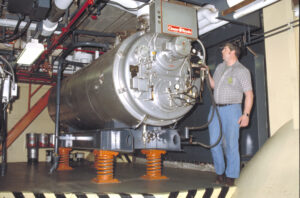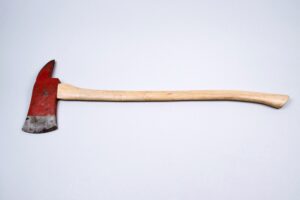New year, new artifact feature! We are pleased to share an object that symbolizes the conflict preparedness necessitated by the Cold War — a fire axe.
The axe is one of the oldest tools known to humanity, dating back to the Early Stone Age where it served as an essential tool for hunter-gatherers. Axes have singlehandedly aided in humanity’s survival and progress over millennia and have continued to evolve to suit a variety of needs. In the early 1900s, the Collins company produced the pick-back style axe. This relatively recent invention was more commonly referred to as a “fire axe” because of its specific design for firefighting. The fire axe was an essential tool in any firefighter’s arsenal, symbolizing strength, bravery, and readiness in the face of danger.

The Diefenbunker Museum Archives
Donated to the museum by a former Diefenbunker personnel, this fire axe from our collections would have been used during the Cold War, a time when safety and preparedness were paramount. At the Diefenbunker, fire prevention is crucial due to the enclosed underground setting of the bunker. The state-of-the-art fire systems that exist within the facility include automatic sensors, a sprinkler system with backup pumps, and doors designed to close automatically during power outages, were put in place during the bunker’s construction between 1959 and 1961. The Diefenbunker operated as the country’s central communications headquarters during the Cold War, ready at any moment in case of a nuclear attack on Canada. Given this, sound structures and systems would have been crucial in order to safely house 500 to 600 designated government officials, military personnel, and civilians who would have been stationed in the bunker for 30-day lockdown if a nuclear attack was detected.

Fire Axe, Diefenbunker Museum: 1999.030.016
Alongside these modern systems, traditional tools like fire axes remained essential as they provided a reliable solution in emergency situations. The pick–back style axe has two sides, each with different uses. The blade can break down building interiors to expose hot spots and damaged structures that have the potential to harm firefighters, and the opposing pick head can pierce through walls and metal to expose hinges for the insertion of powered cutting tools.
The expertise of staff like Pierre Remillard, Wayne Byrne, and Terry Currie ensured the bunker’s vital systems operated flawlessly. Remillard, who worked on construction and maintenance of the building from 1960 through to 1992, played a crucial part in managing the complex machinery and technical equipment essential for the bunker’s functionality. Byrne, who worked on the construction and maintenance of the bunker from 1958 through to 1983, and Currie, who worked on the early-age construction of the building, were other indispensable operators. Like the fire axe, these individuals and many others provided a foundation of trust and safety within the high-stakes environment of the Diefenbunker, which ultimately aided in safeguarding the nation’s security.
Learn more about these essential individuals and their pivotal role within the Diefenbunker:
Pierre Remillard
Wayne Byrne
Terry Currie
Stay tuned as we continue to uncover other stories told by the Cold War artifacts within our museum’s collections.
